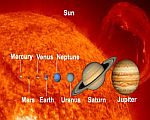- Home
- Our Solar System
- Planet V
Planet V - possibly existing in the early Solar System
Planet V (the "V" being the Roman numeral for "five") is the name assigned to a theoretical planet once existing in the early Solar System between Mars and the Asteroid Belt. It was proposed as a possible theory to explain an event called the "Late Heavy Bombardment" and no longer exists today at it eventually plunged into the Sun.
Let's explore this idea in more detail...
The Late Heavy Bombardment
Again, this event is hypothetical, too. It is thought to have happened some four billion years ago, very early in the life of the Solar System. At this time, Mercury, Venus, Earth, our Moon and Mars experienced a lot more collisions than usual from objects originating in the Asteroid Belt. This event was christened the Late Heavy Bombardment, or LHB. Some scientists also refer to it as the Lunar Cataclysm.
This theory is primarily as a result of examination of rocks brought back from the Moon by the Apollo astronauts. Analysis suggested that the rocks were melted by collisions all within a relatively narrow time band. The fact that an event which affected the four inner planets was theorised based on such a tiny sample of rocks caused some scientists to be very sceptical that it ever happened.
However, assuming it did, there were several theories put forward to explain its cause and the subject of this page is one of them.
Planet V
So called because, if it had existed, it would have been the fifth planet from the Sun, it has been proposed to have been positioned near the Asteroid Belt, with the potential to severely disrupt the orbits of some of them, sending them tumbling into the inner Solar System.
When formed (at the same time as the other four inner planets) it would have been around 170,000,000 miles out from the Sun, affecting a fairly stable orbit. However, over the course of millions of years, gravitational effects from the other four inner planets would send this orbit into ever increasing eccentricity, eventually sending it into the Asteroid Belt.
The theory was first proposed by NASA scientists John Chambers and Jack Lissauer. They conducted computer simulations of the early Solar System and concluded that, if their planet had a mass one-quarter that of Mars, its increasingly eccentric orbit's effect on the Asteroid Belt would produce results consistent with the LHB.
The planet no longer exists today because its orbit would become so crazy it would have crashed into the Sun.
To this day, the one-time existence of Planet V is still under debate.









Facebook Comments
Have your say about what you just read! Leave me a comment in the box below.